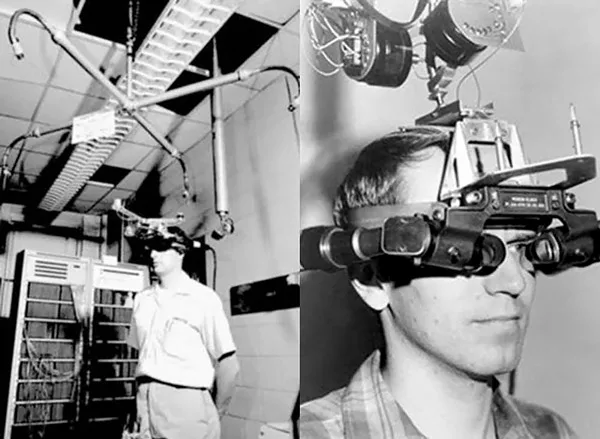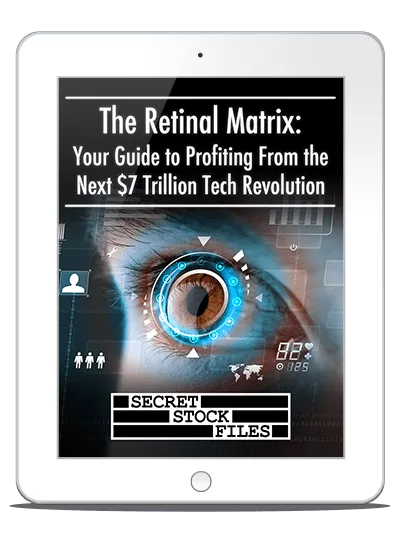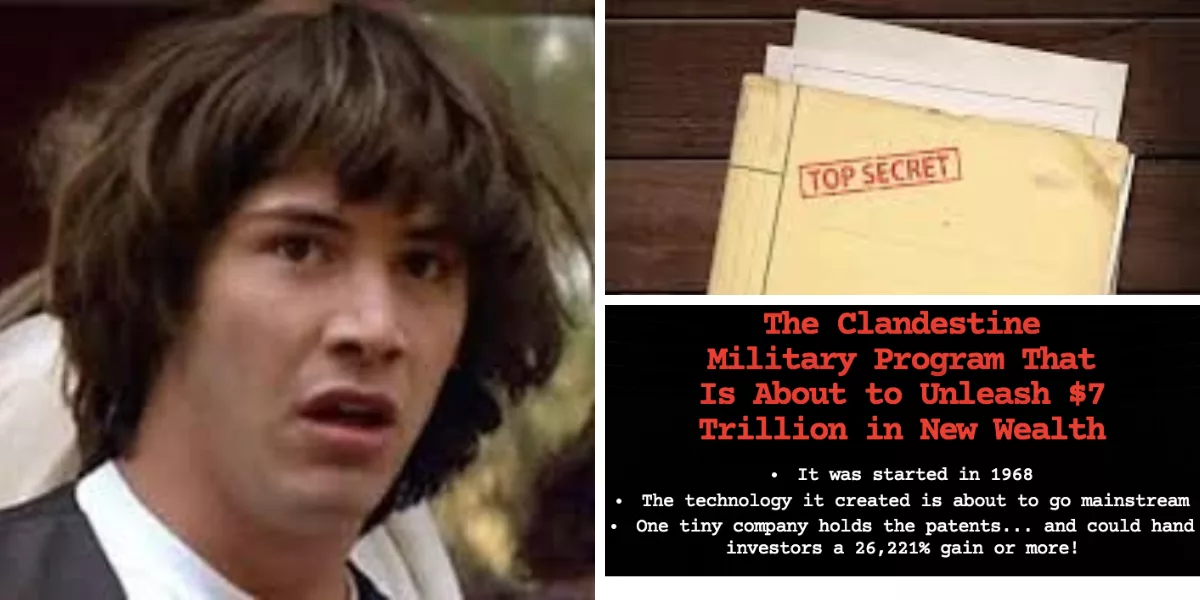Every year, the United States government spends over $80 billion on a set of clandestine military programs called “The Black Budget.”
The technology it creates often revolutionizes the world and Jason Simpkins says one such “Retinal Matrix” Company is about to make some incredibly wealthy.
The Teaser
Top-secret technological breakthroughs, shadowy government figures… is the curtain finally being pulled back?

Jason Simpkins spent 15 years mired in the swamp of Washington D.C. as an investment journalist, making him uniquely qualified to deliver this brief.
We have covered some of his previous work here on Green Bull, including the “Smart Missile” Company to turn $2,500 Into $901,500 and an Alameda-based Rocket Company to make 8,933%.
I'm not getting my hopes up about any major hidden technological revelations in this teaser.
However, I am looking forward to what company(s) will be revealed as being funded or even founded with our tax dollars.
Jason's presentation kicks off with an interesting question…
What is the one thing that the iPhone, the internet, and baby formula all have in common?
If you said “created by a secret government program” you'd be right.
Of the 34 separate components inside the iPhone, no less than seven were born out of secretive government programs.
This includes lithium-ion batteries, which were developed by the Department of Energy. The liquid crystal display that makes up your phone’s screen, was created jointly by the Department of Defense and the National Science Foundation.
Even GPS was originally developed by The Navy.
The key is that when these technologies make their way to the public, they often create untold wealth for companies, consumers, and investors. That's what this teaser is about.
This process is about to unfold again, only this time, the technology that’s about to be commercialized “will be bigger than the iPhone.”
Digital Matrix Multiplier
The tech being teased was first developed in a covert DARPA lab more than 53 years ago.
At the time, Ivan Sutherland was the director of DARPA’s Information Processing Techniques Office, and this is him wearing a contraption on his head called a “digital matrix multiplier” or as Jason calls it, the “Retinal Matrix.”

The device was capable of projecting a 2D image onto its user’s retina, tricking the brain into thinking it was seeing a 3D object.
Fast forward 53 years and the “Retinal Matrix” has finally matured into what could be “the next big thing” and one company is helping commercialize it.
The Pitch
Its name is only revealed in a special investment dossier called “The Retinal Matrix: Your Guide to Profiting From the Next $7 Trillion Tech Revolution.”

The dossier can be ours with a subscription to Jason's investment research service – Secret Stock Files.
A subscription costs $1,999 and comes with a 90-day, 100% money-back guarantee, two bonus dossiers, a weekly roundup of Jason's latest findings, timely alerts via email or text, and monthly video briefings containing brand-new emerging technologies.
A Blending of Reality
Since 1968 the “Retinal Matrix” technology has been getting better and better and it's slowly been making its way into our everyday lives.
Some will see this and immediately think AR/VR, but it goes beyond that.
As an example, high-performance display technology was responsible for one of the most popular mobile games ever.
Launched on the App Store in 2016, Pokemon GO uses a form of display technology, enabling players to find and capture Pokémon hiding in the world around them, on their phones.

The game had more than 147 million monthly active users at its peak and generated more than $6 billion in revenue for its developers.
However, display tech has also made its way into retail, with similar results.
One of the leading cosmetic chains, Sephora, was among the first to experiment with display technology.
The retailer developed an app where users can apply lipstick, blush, and other cosmetics to a live image of their face, either in the store or on their phone.

According to a recent survey, 72% of shoppers reported buying a product they hadn’t planned on purchasing because they had demoed it with display technology.
Given the results, it's no surprise that dozens of other brands like Coca-Cola, Nike, Kate Spade, Lacoste, Warby Parker, and even Patron Tequila (virtual bar shots?) are starting to use the technology.
High-performance display technology has already become an indispensable part of e-commerce, but Jason is predicting that it won't stop here.
This year, use cases are expected to top $6.6 billion, so it's still early days for the tech, but the kicker is that a tiny DARPA-funded government contractor holds all the patents that are critical to creating the display technology that other companies now rely on.
Revealing Jason Simpkins' “Retinal Matrix” Company
This isn't any of the “usual suspects” like Raytheon, Boeing, or Northrop Grumman.
Instead, Jason says it's a company we've probably never heard of before. Here is what we know about it:
- According to Jason's D.C. sources, this company holds 300 patents and is going to be the main supplier for the entire $7 trillion Retinal Matrix industry.
- It’s already inked a $52 million deal to supply critical “Retinal Matrix” components for the Army’s Family of Weapon Sight Programs.
- Right now, it’s trading for just under $5 a share.
Following some internet sleuthing, the pick here is Kopin Corp. (Nasdaq: KOPN). The clues align like the bold letters on a DMV eye test.
- The company has previously stated that its technology is protected by “more than 300 global patents and patents pending.”
- Last summer, Kopin announced a new contract with the US Army to develop retinal imaging optics for dismounted soldier vision systems.
- After slumping, Kopin stock is now down below $2, but it was up near $5 when this updated teaser was initially released.
Turn Every $500 into $131,600 or More?
If you had sunk $500 into Kopin stock in February 2020, you would have approximately $2,200 today.
Not exactly $131K is it, but is Kopin's reality-altering tech about to take off?
Don't bet on it.
The lack of adoption of the Apple Vision Pro has dampened expectations for display and optical technology providers.
Although the consumer segment was never a big revenue generator for Kopin, that is defense and R&D contracts, its stock was lumped in and pummeled along with all AR/VR stocks.
However, there are other reasons for its drop as well. Namely, despite its defense contracts and intellectual property, the company has yet to achieve positive cash flow.
There is also the not-insignificant matter of Kopin having a $24.8 million legal judgment go against them related to the inventorship of at least ten patents.
For a business with negative cash flow and $37 million in total cash on its balance sheet, it's a big blow. Unless the ruling is overturned, it means it will likely have to raise additional operating capital, so more dilution for shareholders is ahead.
The bottom line is, I'm no engineer and can't tell you how good or not, Kopin's tech is. But I can tell you that its underlying economics are not good and could get worse if the legal judgment sticks.
Unless something drastic happens, I don't foresee a 26,000% jump in Kopin's share price over the short term.
Quick Recap & Conclusion
- Well-connected investment analyst Jason Simpkins is teasing a clandestine military technology called “Retinal Matrix” and one small defense contractor behind it.
- What Jason is teasing is a high-performance display technology used by a wide variety of defense, enterprise, and research customers.
- The name of the company helping to commercialize it is only revealed in a special investment dossier called “The Retinal Matrix: Your Guide to Profiting From the Next $7 Trillion Tech Revolution.” The dossier can be ours with a subscription to Jason's brand-new investment research service – Secret Stock Files, which costs $1,999 to join.
- However, if you read the Green Bull, you got it for free! Its Kopin Corp. (Nasdaq: KOPN).
- Kopin may have some intellectual property protecting its display and optical technology, but this is where the positives end. The company is in the red, it has a large potential legal liability hanging over its head and is very likely to further dilute shareholders.
Can display technology be a profitable investment? Give us your thoughts in the comments.

